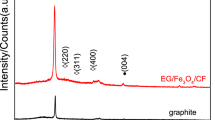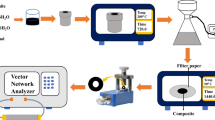Abstract
The dielectric loss mechanism in low-dimensional carbon-based absorbing composites remains obscured, and clarifying the loss origin is beneficial for the design and preparation of high-performance electromagnetic absorbing materials. In this work, quasi-2D NiFe hydrotalcite/less layer graphite composites are synthesized by high-speed liquid shear method. The measurements of the microwave absorption show that it has a broadband absorption property. Particle swarm optimization algorithm is used to analyze and confirm the coexistence loss mechanism of Debye-relaxation and Drude–Lorentz resonance absorption in this material. The morphology, X-ray photoelectron spectroscopy and Raman spectroscopy characterization further elucidate that the quasi-2D interface between functional particles and carbon-based sheets is the physical origin for the enhancement of Drude–Lorentz resonance absorption. This study provides a novel strategy for improving the absorbing performance of carbon-based composite materials.




Similar content being viewed by others
References
S. Li, X. Tang, X. Zhao, S. Lu, J. Luo, Z. Chai, T. Ma, Q. Lan, P. Ma, W. Dong et al., Hierarchical graphene@MXene composite foam modified with flower-shaped FeS for efficient and broadband electromagnetic absorption. J. Mater. Sci. Technol. 133, 238–248 (2023)
X. Liu, X. Zhao, J. Yan, Y. Huang, T. Li, P. Liu, Enhanced electromagnetic wave absorption performance of core-shell Fe3O4@poly (3, 4-ethylenedioxythiophene) microspheres/reduced graphene oxide composite. Carbon 178, 273–284 (2021)
Z. Liu, F. Pan, B. Deng, Z. **ang, W. Lu, Self-assembled MoS2/3D worm-like expanded graphite hybrids for high-efficiency microwave absorption. Carbon 174, 59–69 (2021)
B. Wei, C. Zhou, Z. Yao, L. Xu, Z. Li, L. Wan, J. Hou, J. Zhou, Lightweight and high-efficiency microwave absorption of reduced graphene oxide loaded with irregular magnetic quantum dots. J. Alloys Compd. 886, 161330 (2021)
F. Li, W. Zhan, Y. Su, S.H. Siyal, G. Bai, W. **ao, A. Zhou, G. Sui, X. Yang, Achieving excellent electromagnetic wave absorption of ZnFe2O4@CNT/polyvinylidene fluoride flexible composite membranes by adjusting processing conditions. Compos. Part A Appl. Sci. Manuf. 133, 105866 (2020)
L. Ren, Y. Wang, Z. Jia, Q. He, G. Wu, Controlling the heterogeneous interfaces of Fe3O4/N-doped porous carbon via facile swelling for enhancing the electromagnetic wave absorption. Compos. Commun. 29, 101052 (2022)
Y. Yao, S. **, J. Sun, L. Li, H. Zou, P. Wen, G. Lv, X. Lv, Q. Shu, Sandwich-like sulfur-free expanded graphite/CoNi hybrids and their synergistic enhancement of microwave absorption. J. Alloys Compd. 862, 158005 (2021)
C. Lei, Y. Du, Tunable dielectric loss to enhance microwave absorption properties of flakey FeSiAl/ferrite composites. J. Alloys Compd. 822, 153674 (2020)
X. Shu, H. Ren, Y. Jiang, J. Zhou, Y. Wang, Y. Wang, Y. Liu, W.-C. Oh, Enhanced electromagnetic wave absorption performance of silane coupling agent KH550@Fe3O4 hollow nanospheres/graphene composites. J. Mater. Chem. C 8(8), 2913–2926 (2020)
Y. Zhang, X. Wang, M. Cao, Confinedly implanted NiFe2O4-rGO: Cluster tailoring and highly tunable electromagnetic properties for selective-frequency microwave absorption. Nano Res. 11(3), 1426–1436 (2018)
M. Qin, L. Zhang, H. Wu, Dielectric loss mechanism in electromagnetic wave absorbing materials. Adv. Sci. 9(10), 2105553 (2022)
J. Feng, F. Pu, Z. Li, X. Li, X. Hu, J. Bai, Interfacial interactions and synergistic eff ect of CoNi nanocrystals and nitrogen-doped graphene in a composite microwave absorber. Carbon 104, 214–225 (2016)
W. **ng, P. Li, H. Wang, Q. Lei, Y. Huang, J. Fan, G. Xu, The similar Cole–Cole semicircles and microwave absorption of Hexagonal Co/C composites. J. Alloys Compd. 750, 917–926 (2018)
P. He, M. Zheng, Q. Liu, Z. Liu, R. Zuo, W. Cao, J. Yuan, M. Cao, MXene nanohybrids: Excellent electromagnetic properties for absorbing electromagnetic waves. Ceram. Int. 48(2), 1484–1493 (2022)
P. Liu, S. Gao, Y. Wang, Y. Huang, Y. Wang, J. Luo, Core–shell CoNi@graphitic carbon decorated on B, N-codoped hollow carbon polyhedrons toward lightweight and high-effi ciency microwave attenuation. ACS Appl. Mater. Interfaces 11(28), 25624–25635 (2019)
F. Liao, X. Zhao, G. Yang, Q. Cheng, L. Mao, L. Chen, Recent advances on two-dimensional NiFe-LDHs and their composites for electrochemical energy conversion and storage. J. Alloys Compd. 872, 159649 (2021)
Z. Wang, R. Wei, J. Gu, H. Liu, C. Liu, C. Luo, J. Kong, Q. Shao, N. Wang, Z. Guo et al., Ultralight, highly compressible and fi re-retardant graphene aerogel with self-adjustable electromagnetic wave absorption. Carbon 139, 1126–1135 (2018)
Y. Zhang, S. Gao, Y. Wang, Metal–organic framework derived magnetic carbon Ni@C octahedron composite as an excellent microwave absorber. Compos. Commun. 31, 101135 (2022)
M. He, Y. Zhou, T. Huang, S. Nie, Y. Wang, Z. Xu, Y. Huo, R. Xu, X. Chen, H. Peng, Flower-like CoS hierarchitectures@polyaniline organic-inorganic heterostructured composites: preparation and enhanced microwave absorption performance. Compos. Sci. Technol. 200, 108403 (2020)
J. Yan, Y. Huang, C. Chen, X. Liu, H. Liu, The 3D CoNi alloy particles embedded in N-doped porous carbon foams for high-performance microwave absorbers. Carbon 152, 545–555 (2019)
M. Eldlio, F. Che, M. Cada, Drude–Lorentz model of semiconductor optical plasmons, in IAENG Transactions on Engineering Technologies Special Issue of the World Congress on Engineering and Computer Science 2012. (Springer, Netherlands, Dordrecht, 2014), pp.41–49
K.S. Cole, R.H. Cole, Dispersion and absorption in dielectrics I. Alternating current characteristics. J. Chem. Phys. 9(4), 341–351 (1941)
J. Shibayama, K. Suzuki, T. Iwamoto, J. Yamauchi, H. Nakano, Dispersive contour-path FDTD algorithm for the Drude–Lorentz model. IEEE Antennas Wirel. Propag. Lett. 19(10), 1699–1703 (2020)
K. Prokopidis, C. Kalialakis, Physical interpretation of a modified Lorentz dielectric function for metals based on the Lorentz–Dirac force. Appl. Phys. B 117(1), 25–32 (2014)
K.H. Lee, I. Ahmed, R.S.M. Goh et al., Implementation of the Fdtd method based on Lorentz–Drude dispersive model on Gpu for plasmonics applications. Prog. Electromagn. Res. 116, 441–456 (2011)
I. Ahmed, E.H. Khoo, O. Kurniawan et al., Modeling and simulation of active plasmonics with the FDTD method by using solid state and Lorentz–Drude dispersive model. J. Opt. Soc. America B 28(3), 352 (2011)
H. Zhao, X. Han, Z. Li, D. Liu, Y. Wang, Y. Wang, W. Zhou, Y. Du, Reduced graphene oxide decorated with carbon nanopolyhedrons as an effi cient and lightweight microwave absorber. J. Colloid Interface Sci. 528, 174–183 (2018)
Funding
This work was supported by Basic Science (Natural Science Research of Jiangsu Higher Education Institutions of China) research project of Jiangsu Province (21KJA430010).
Author information
Authors and Affiliations
Corresponding author
Ethics declarations
Conflict of interest
The authors declare that they have no known competing financial interests or personal relationships that could have appeared to influence the work reported in this paper.
Additional information
Publisher's Note
Springer Nature remains neutral with regard to jurisdictional claims in published maps and institutional affiliations.
Supplementary Information
Below is the link to the electronic supplementary material.
Rights and permissions
Springer Nature or its licensor (e.g. a society or other partner) holds exclusive rights to this article under a publishing agreement with the author(s) or other rightsholder(s); author self-archiving of the accepted manuscript version of this article is solely governed by the terms of such publishing agreement and applicable law.
About this article
Cite this article
Jiang, C., Liu, D., Wang, R. et al. Drude–Lorentz resonance absorption in quasi-2D NiFe hydrotalcite/less layer graphite composites. Appl. Phys. A 129, 379 (2023). https://doi.org/10.1007/s00339-023-06657-3
Received:
Accepted:
Published:
DOI: https://doi.org/10.1007/s00339-023-06657-3




